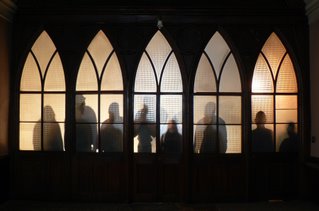
If, like many preservationists, architects, planners, and urban historians, you once read The Power Broker, Robert Caro's monumental biography of Robert Moses, you will be interested to know that three exhibitions reevaluating Moses' legacy will soon be opening in New York City.
Curated by Hilary Ballon, an architectural historian and professor at Columbia University's Department of Art History and Archeology, the Robert Moses and the Modern City exhibition has three components: Remaking the Metropolis at the Museum of the City of New York, The Road to Recreation at the Queens Museum of Art, and Slum Clearance and the Superblock Solution at the Wallach Art Gallery at Columbia University.
The New York Times has published several articles about Robert Moses and the exhibitions this week:
-- Rehabilitating Robert Moses (Robin Pogrebin, January 23, 2007) which includes a brief video of Robin Pogrebin interviewing exhibition curator Hilary Ballon and a slide show of selected Moses projects.
-- Complex, Contradictory Robert Moses (Nicolai Ouroussoff, February 2, 2007), an exhibition review which opines that "the show should be required viewing for all government bureaucrats involved in urban policy -- no, for anyone who loves New York." A related piece, Three Aspects of New York's Master Builder, provides brief details about locations, dates, times, etc.
In a related article, The New York Times' On the Town, Sized Down, Jazzed Up (Corey Kilgannon, February 2, 2007) describes the somewhat unknown New York City Panorama at the Queens Museum of Art, which Robert Moses had built for the 1964 World's Fair. As Kilgannon notes, "The model was built with incredible topological and architectural accuracy. Its roughly 895,000 tiny buildings, streets, parks and bridges are made mostly of wood and plastic and all built to scale, from bridge length to park acreage to skyscraper height. The 321 square miles of the city’s five boroughs are sprawled over the model’s 9,335 square feet. An inch equals 100 feet, Far Rockaway is a jump shot from Central Park, and the 1,500-foot-tall Empire State Building is 15 inches. The beach at Coney Island is just over 13 feet long, the Staten Island ferry would travel 22 feet, and the Bronx Zoo covers 1,500 square inches."
The Panorama has recently been upgraded to include multimedia components and is being reopened in association with the Moses exhibitions.

As a final note, those interested in Robert Moses legacy and era should also check out the LaGuardia and Wagner Archives Photo Exhibit and Illustrated Guide to Public Housing, by Joel Schwartz. Entitled Public Housing: New York Tranformed: 1939-1967, the 2004 exhibition features incredible "never-before-seen images selected from thousands of 4x5 inch negatives from the New York City Housing Authority Collection." Schwartz's introduction is well worth reading with great illustrations, and many of the photographs in the collection are reminiscent of the work of Berenice Abbot (as the two photographs included here show; the quality of the original images is much better).
The photographs document existing conditions in the areas of the city where public housing would be built, showing people (residents and business owners), buildings, streetscapes, and more. These images form an amazing visual record and are not to be missed.


